Go.pajosh.com (Removal Instructions) - Free Guide
Go.pajosh.com Removal Guide
What is Go.pajosh.com?
Go.pajosh.com is a deceptive application that collects data about users to generate an online profile
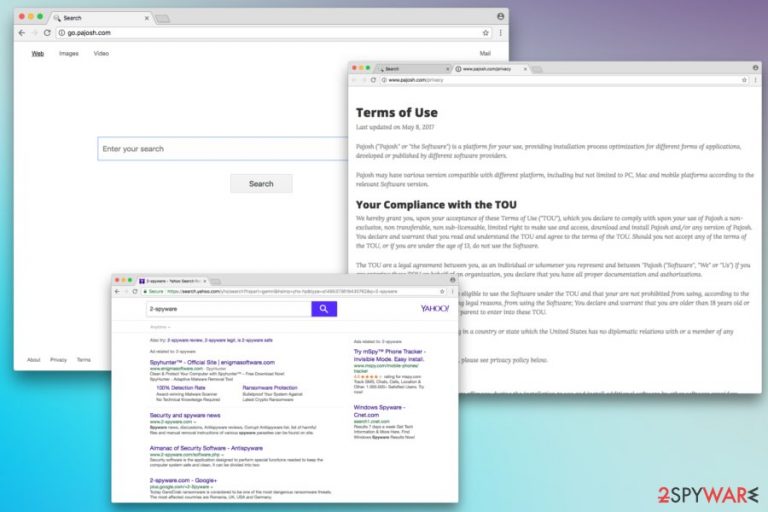
Go.pajosh.com is a fake search engine and a browser hijacker, as it modifies Google Chrome’s or other browser’s settings (it changes the new tab URL and homepage to hxxp://go.pajosh.com) without permission and redirects all searches to Yahoo. This questionable application usually infiltrates users’ machines via software bundling – a deceitful technique used by free software and PUP developers. It also promises users a “guaranteed installation” of programs with the “robust Installation Manager.”
| Summary | |
| Name | Go.pajosh.com |
|---|---|
| Type | Browser hijacker |
| Main dangers | Malware infection, fraudulent downloads, excessive user data gathering, etc. |
| Symptoms | Intrusive advertisement, altered browser settings and search results, slow browser response time, etc. |
| Distribution | Software bundling |
| Elimination | Either download and install FortectIntego or check our instructions below |
Pajosh is very similar to other browser hijackers out there – Wkalle.com, Search.pitchofcase.com, Secure-surf.net and many others. The similarities are not only visual, though: functionality of these applications is very alike. All of these applications study and scrutinize online behavior of users to create a virtual profile.
This profile is used to generate a targeted advertisement in the form of redirects, pop-ups, and other misleading ads. This behavior disturbs users' browsing sessions on a daily basis. To stop this activity, you need to remove Go.pajosh.com by either using reputable security software (like FortectIntego) or eliminating the PUP manually.
To acquire enough information about users, developers of Go.pajosh.com virus uses various tracking technologies, including beacons, cookies,[1] pixels, JavaScript and many others. The collected data includes, but is not limited to:
- Geolocation;
- IP address;
- Sites visited;
- Links clicked;
- Software installed and its version;
- Hardware information;
- Installation process information, etc.
As you can see, the browser hijacker tries to find out as much about you as possible. The targeted advertisement helps Pajosh developers to generate pay-per-click[2] or pay-per-install revenue, boosting traffic of affiliated websites. What is more, even though search results are redirected to Yahoo (a legitimate search engine), the layer of ads is added; as a result, the generated results are not entirely genuine.
Another not only undesirable but an also dangerous feature of Go.pajosh.com hijack is its redirecting tendencies. Users might be lead to suspicious websites, including phishing, fake software or even malware-infested sites. The latter can result in spyware, trojan or even ransomware infection. Besides, other crapware might be installed without your permission and clutter your browser.
As evident, there are no benefits of keeping a browser hijacker on your machine. As the unwanted app redirects all searches to Yahoo, you might as well use it instead. To proceed with Go.pajosh.com removal, check our guide below.

Protect your PC from unwanted applications
PUPs typically enter users’ machines without them knowing simply because of lack of knowledge. Victims download free software online and install it while skipping steps and rushing the installation process. These unwanted apps are hidden as additional components inside the free software installers, as it benefits both – freeware and PUP developers.
Thus, it is their biggest interest for you to use Recommended or Quick installation settings, where all the unwanted applications are hidden. To not get tricked by this technique, always pick Advanced or Custom installation settings. If you see any add-ons, search engines, system optimizers, etc., decline their installation by removing all the tick marks next to these dubious apps.
Security experts[3] advise users never to install apps which are bundled. Instead, they urge users to do some research and find legitimate counterparts online.
Ways to remove Go.pajosh.com virus
If you see random ads and suspicious redirects on your browser continuously, it is time to check for unwanted programs. It would not be surprising if the computer is infested with multiple PUPs – they multiply at a rapid pace, especially after extensive use.
Fortunately, Go.pajosh.com removal can be completed easily. If you want to eliminate the PUP quickly and effortlessly, we recommend downloading and installing reputable anti-spyware software and performing a full system scan. This method allows users to check for all kinds of infections – including malware.
If you are not keen on additional software installation, you can remove Pajosh virus by using our illustrated instructions below. This method requires you to execute each step of the tutorial attentively and then reset each of the affected browsers manually.
You may remove virus damage with a help of FortectIntego. SpyHunter 5Combo Cleaner and Malwarebytes are recommended to detect potentially unwanted programs and viruses with all their files and registry entries that are related to them.
Getting rid of Go.pajosh.com. Follow these steps
Uninstall from Windows
To eliminate Pajosh from Windows OS, follow these steps:
Instructions for Windows 10/8 machines:
- Enter Control Panel into Windows search box and hit Enter or click on the search result.
- Under Programs, select Uninstall a program.

- From the list, find the entry of the suspicious program.
- Right-click on the application and select Uninstall.
- If User Account Control shows up, click Yes.
- Wait till uninstallation process is complete and click OK.

If you are Windows 7/XP user, proceed with the following instructions:
- Click on Windows Start > Control Panel located on the right pane (if you are Windows XP user, click on Add/Remove Programs).
- In Control Panel, select Programs > Uninstall a program.

- Pick the unwanted application by clicking on it once.
- At the top, click Uninstall/Change.
- In the confirmation prompt, pick Yes.
- Click OK once the removal process is finished.
Delete from macOS
Mac's users can delete unwanted app by following this guide:
Remove items from Applications folder:
- From the menu bar, select Go > Applications.
- In the Applications folder, look for all related entries.
- Click on the app and drag it to Trash (or right-click and pick Move to Trash)

To fully remove an unwanted app, you need to access Application Support, LaunchAgents, and LaunchDaemons folders and delete relevant files:
- Select Go > Go to Folder.
- Enter /Library/Application Support and click Go or press Enter.
- In the Application Support folder, look for any dubious entries and then delete them.
- Now enter /Library/LaunchAgents and /Library/LaunchDaemons folders the same way and terminate all the related .plist files.

Remove from Microsoft Edge
Do not forget to reset your MS Edge browser:
Delete unwanted extensions from MS Edge:
- Select Menu (three horizontal dots at the top-right of the browser window) and pick Extensions.
- From the list, pick the extension and click on the Gear icon.
- Click on Uninstall at the bottom.
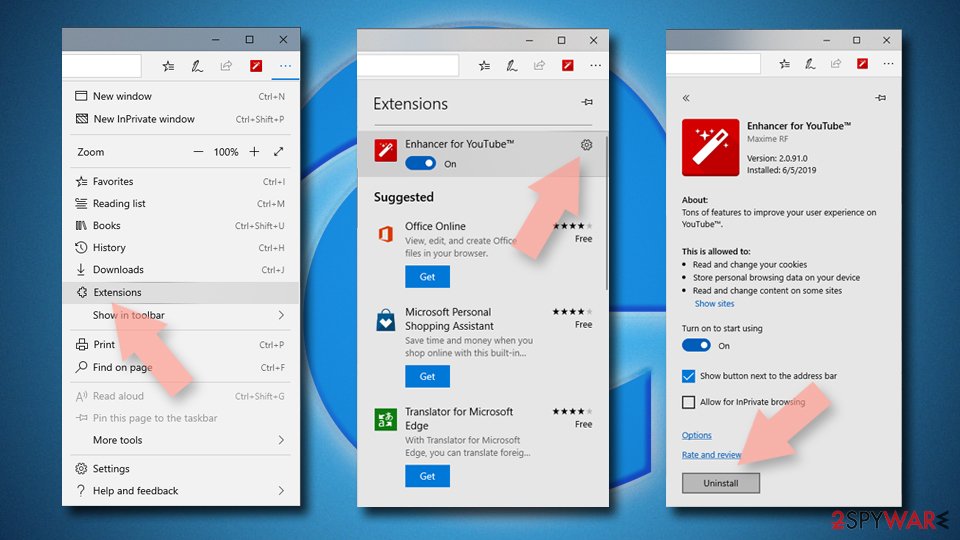
Clear cookies and other browser data:
- Click on the Menu (three horizontal dots at the top-right of the browser window) and select Privacy & security.
- Under Clear browsing data, pick Choose what to clear.
- Select everything (apart from passwords, although you might want to include Media licenses as well, if applicable) and click on Clear.
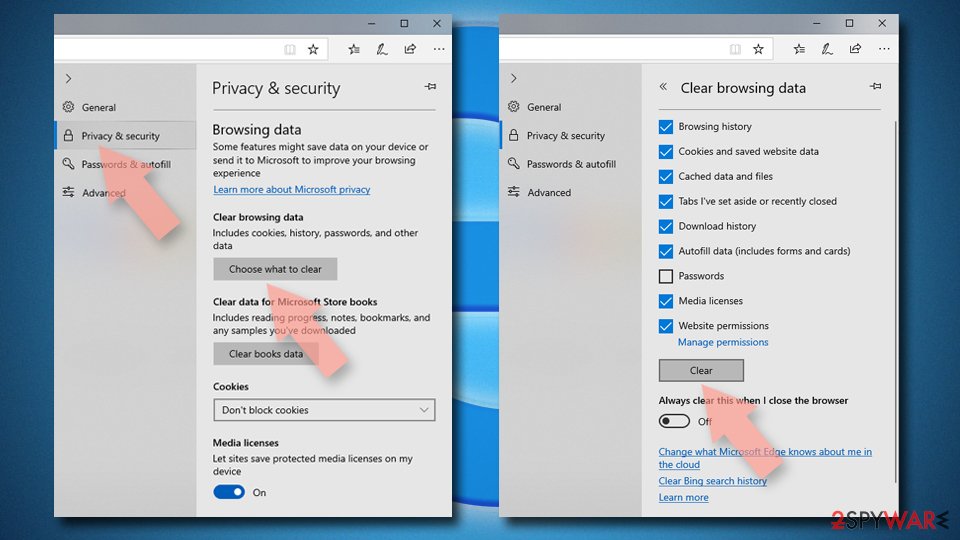
Restore new tab and homepage settings:
- Click the menu icon and choose Settings.
- Then find On startup section.
- Click Disable if you found any suspicious domain.
Reset MS Edge if the above steps did not work:
- Press on Ctrl + Shift + Esc to open Task Manager.
- Click on More details arrow at the bottom of the window.
- Select Details tab.
- Now scroll down and locate every entry with Microsoft Edge name in it. Right-click on each of them and select End Task to stop MS Edge from running.
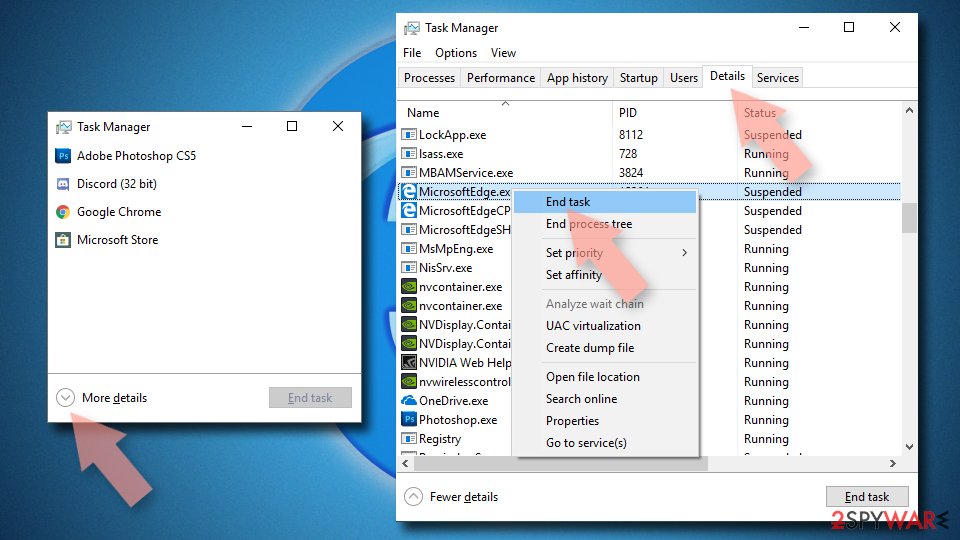
If this solution failed to help you, you need to use an advanced Edge reset method. Note that you need to backup your data before proceeding.
- Find the following folder on your computer: C:\\Users\\%username%\\AppData\\Local\\Packages\\Microsoft.MicrosoftEdge_8wekyb3d8bbwe.
- Press Ctrl + A on your keyboard to select all folders.
- Right-click on them and pick Delete

- Now right-click on the Start button and pick Windows PowerShell (Admin).
- When the new window opens, copy and paste the following command, and then press Enter:
Get-AppXPackage -AllUsers -Name Microsoft.MicrosoftEdge | Foreach {Add-AppxPackage -DisableDevelopmentMode -Register “$($_.InstallLocation)\\AppXManifest.xml” -Verbose

Instructions for Chromium-based Edge
Delete extensions from MS Edge (Chromium):
- Open Edge and click select Settings > Extensions.
- Delete unwanted extensions by clicking Remove.
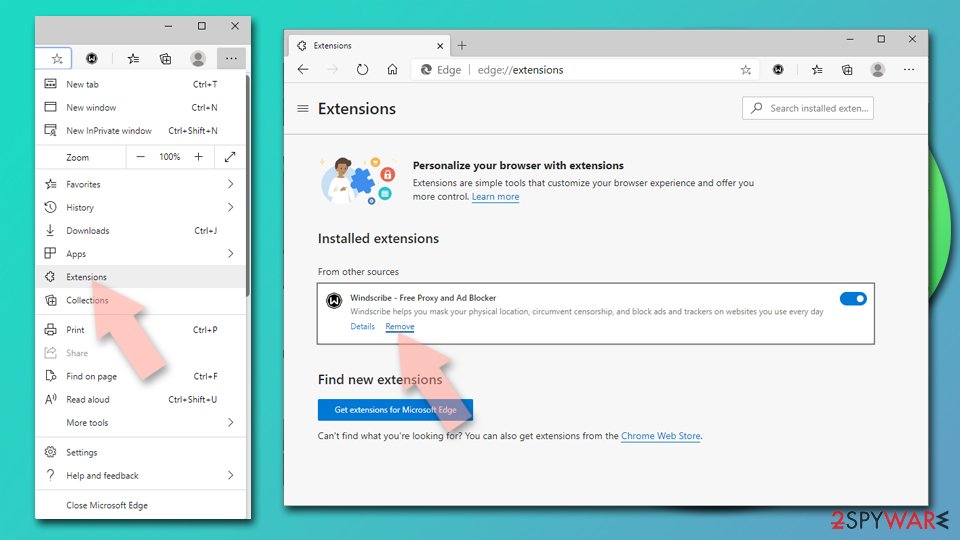
Clear cache and site data:
- Click on Menu and go to Settings.
- Select Privacy, search and services.
- Under Clear browsing data, pick Choose what to clear.
- Under Time range, pick All time.
- Select Clear now.
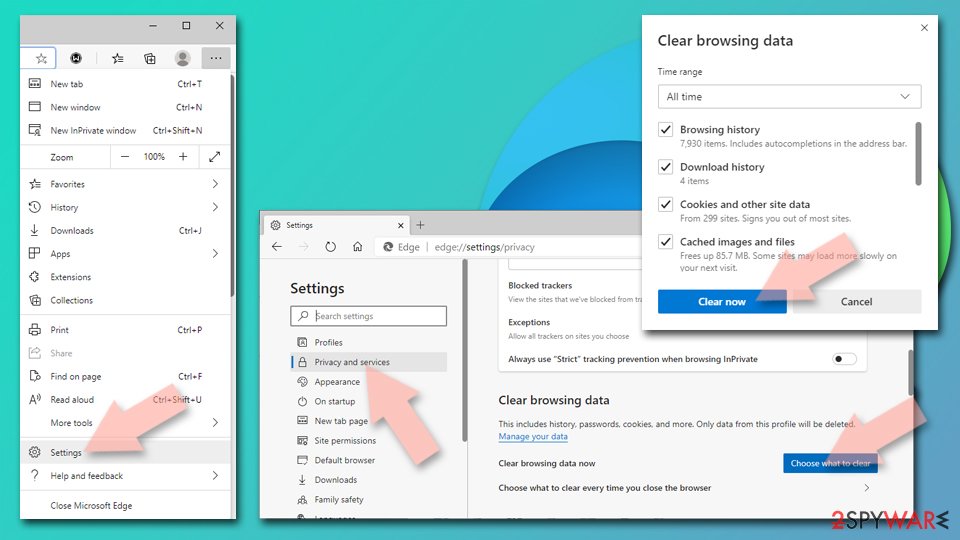
Reset Chromium-based MS Edge:
- Click on Menu and select Settings.
- On the left side, pick Reset settings.
- Select Restore settings to their default values.
- Confirm with Reset.
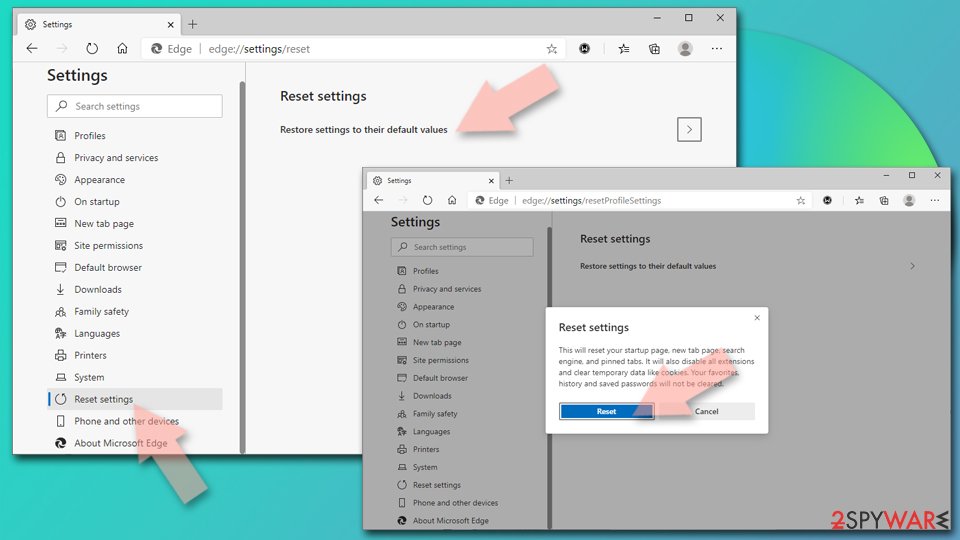
Remove from Mozilla Firefox (FF)
Remove dangerous extensions:
- Open Mozilla Firefox browser and click on the Menu (three horizontal lines at the top-right of the window).
- Select Add-ons.
- In here, select unwanted plugin and click Remove.

Reset the homepage:
- Click three horizontal lines at the top right corner to open the menu.
- Choose Options.
- Under Home options, enter your preferred site that will open every time you newly open the Mozilla Firefox.
Clear cookies and site data:
- Click Menu and pick Settings.
- Go to Privacy & Security section.
- Scroll down to locate Cookies and Site Data.
- Click on Clear Data…
- Select Cookies and Site Data, as well as Cached Web Content and press Clear.
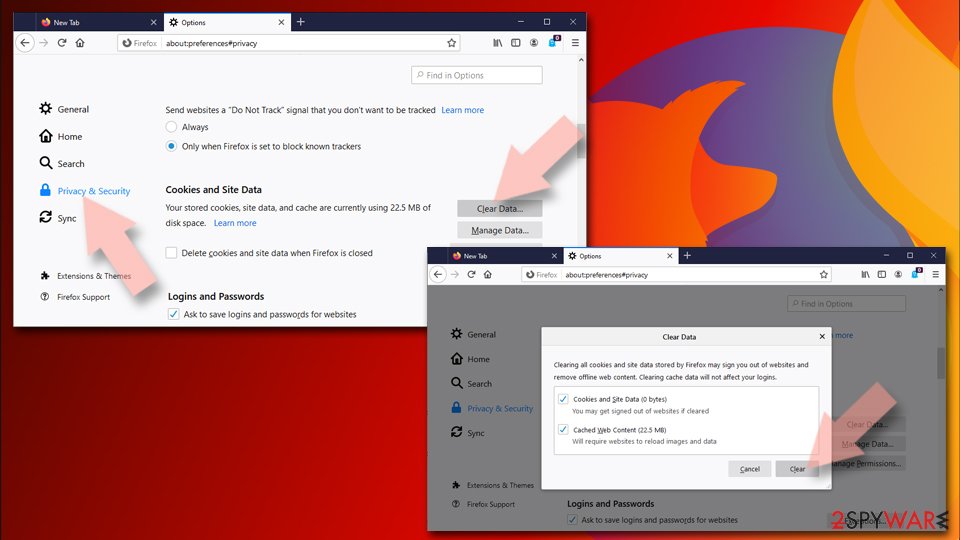
Reset Mozilla Firefox
If clearing the browser as explained above did not help, reset Mozilla Firefox:
- Open Mozilla Firefox browser and click the Menu.
- Go to Help and then choose Troubleshooting Information.
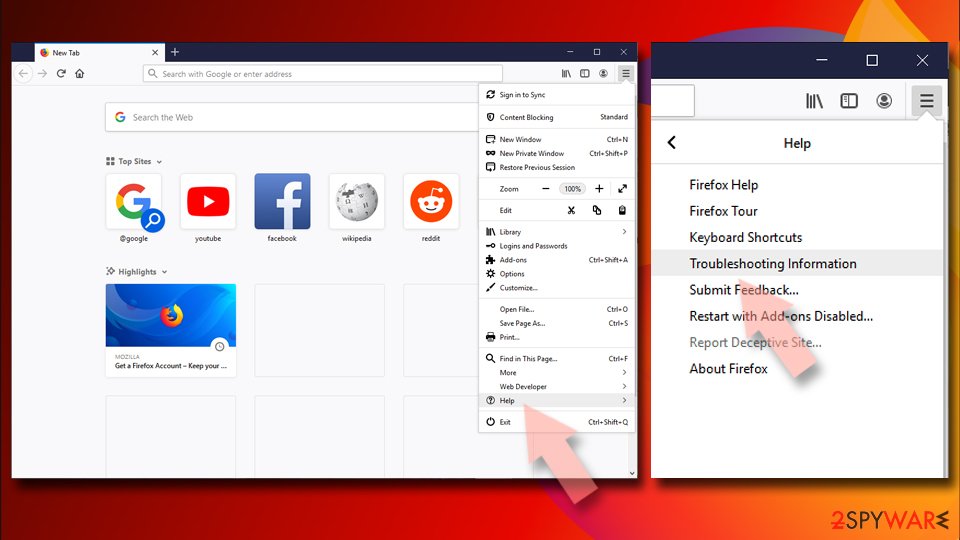
- Under Give Firefox a tune up section, click on Refresh Firefox…
- Once the pop-up shows up, confirm the action by pressing on Refresh Firefox.
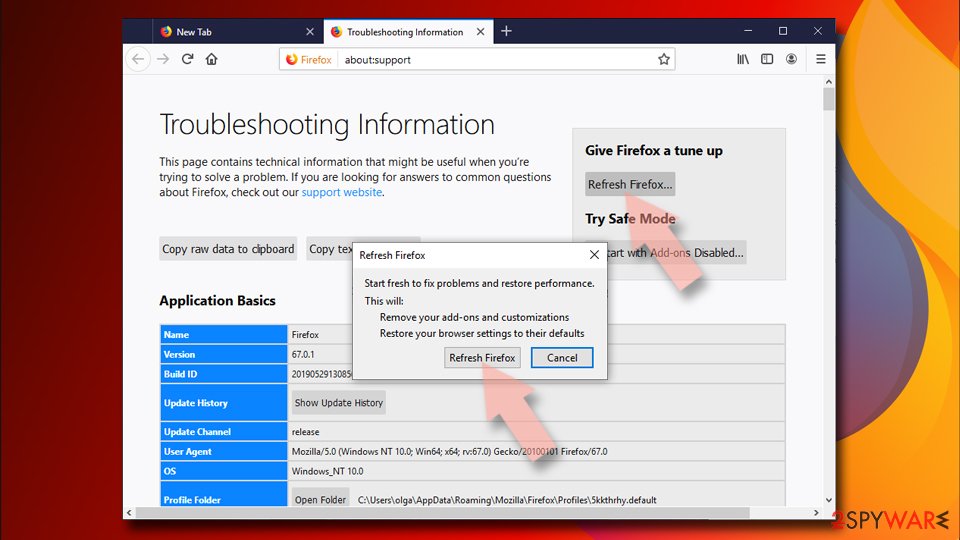
Remove from Google Chrome
Delete malicious extensions from Google Chrome:
- Open Google Chrome, click on the Menu (three vertical dots at the top-right corner) and select More tools > Extensions.
- In the newly opened window, you will see all the installed extensions. Uninstall all the suspicious plugins that might be related to the unwanted program by clicking Remove.

Clear cache and web data from Chrome:
- Click on Menu and pick Settings.
- Under Privacy and security, select Clear browsing data.
- Select Browsing history, Cookies and other site data, as well as Cached images and files.
- Click Clear data.

Change your homepage:
- Click menu and choose Settings.
- Look for a suspicious site in the On startup section.
- Click on Open a specific or set of pages and click on three dots to find the Remove option.
Reset Google Chrome:
If the previous methods did not help you, reset Google Chrome to eliminate all the unwanted components:
- Click on Menu and select Settings.
- In the Settings, scroll down and click Advanced.
- Scroll down and locate Reset and clean up section.
- Now click Restore settings to their original defaults.
- Confirm with Reset settings.
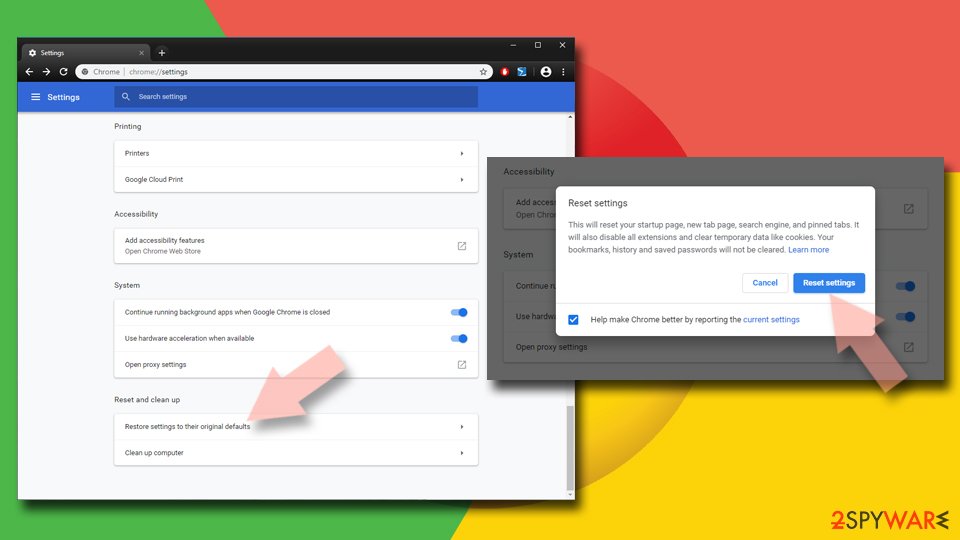
Delete from Safari
Remove unwanted extensions from Safari:
- Click Safari > Preferences…
- In the new window, pick Extensions.
- Select the unwanted extension and select Uninstall.
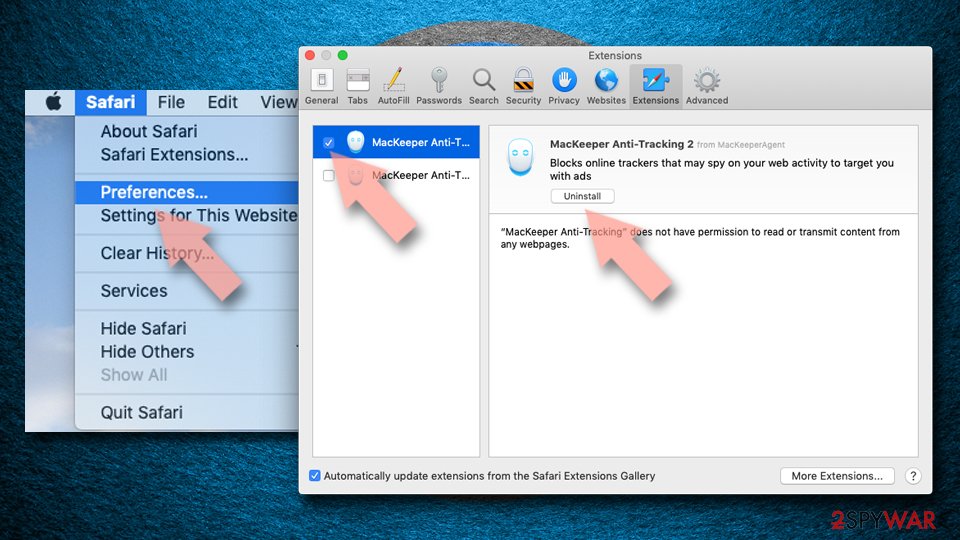
Clear cookies and other website data from Safari:
- Click Safari > Clear History…
- From the drop-down menu under Clear, pick all history.
- Confirm with Clear History.
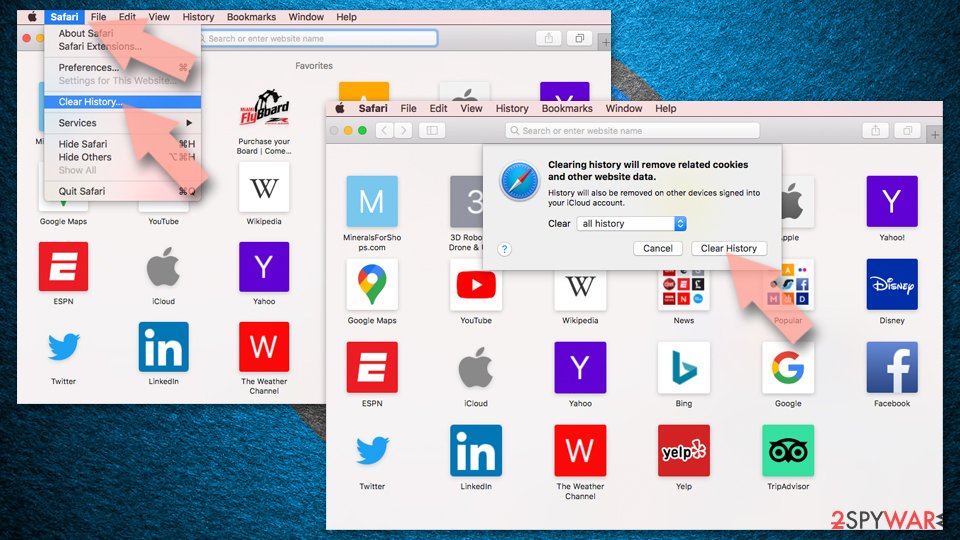
Reset Safari if the above-mentioned steps did not help you:
- Click Safari > Preferences…
- Go to Advanced tab.
- Tick the Show Develop menu in menu bar.
- From the menu bar, click Develop, and then select Empty Caches.
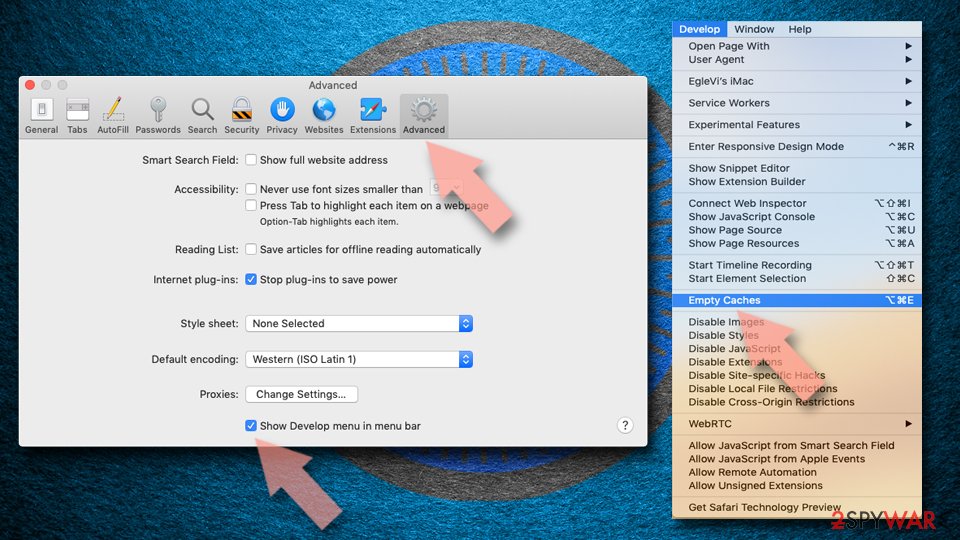
After uninstalling this potentially unwanted program (PUP) and fixing each of your web browsers, we recommend you to scan your PC system with a reputable anti-spyware. This will help you to get rid of Go.pajosh.com registry traces and will also identify related parasites or possible malware infections on your computer. For that you can use our top-rated malware remover: FortectIntego, SpyHunter 5Combo Cleaner or Malwarebytes.
How to prevent from getting stealing programs
Stream videos without limitations, no matter where you are
There are multiple parties that could find out almost anything about you by checking your online activity. While this is highly unlikely, advertisers and tech companies are constantly tracking you online. The first step to privacy should be a secure browser that focuses on tracker reduction to a minimum.
Even if you employ a secure browser, you will not be able to access websites that are restricted due to local government laws or other reasons. In other words, you may not be able to stream Disney+ or US-based Netflix in some countries. To bypass these restrictions, you can employ a powerful Private Internet Access VPN, which provides dedicated servers for torrenting and streaming, not slowing you down in the process.
Data backups are important – recover your lost files
Ransomware is one of the biggest threats to personal data. Once it is executed on a machine, it launches a sophisticated encryption algorithm that locks all your files, although it does not destroy them. The most common misconception is that anti-malware software can return files to their previous states. This is not true, however, and data remains locked after the malicious payload is deleted.
While regular data backups are the only secure method to recover your files after a ransomware attack, tools such as Data Recovery Pro can also be effective and restore at least some of your lost data.
- ^ ARCHIVED: What are cookies?. Indiana University. Knowledge base.
- ^ Pay-per-click. Wikipedia. The Free Encyclopedia.
- ^ Viruset. Viruset. Norwegian security experts.
